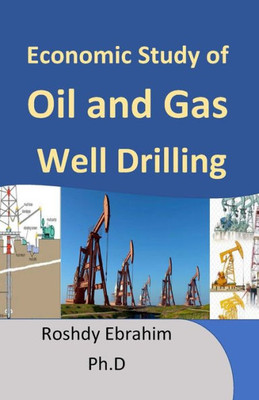
Economic study of Oil and Gas Well Drilling
Independently published
ISBN13:
9781980691334
$17.52
A revolutionary invention in 1909 greatly increased the depth of wells that could be drilled. The original drilling technology, adapted from water well drilling, was to drop a heavy "bit" onto the rock. The rock would shatter and be periodically removed by a scoop. This method is slow, inefficient and not feasible below a thousand meters or so. The far more efficient continuous hydraulic rotary drilling system used today was invented by Hughes Tool Co. c. 1900. It consisted of a rotary cutting tool at the bottom end of a pipe, which was rotated as a whole by an engine at the top. A lubricant was pumped down from above, both to cool the drill and to carry the cuttings back to the surface outside the pipe. This enabled the drill to operate continuously, except for pauses to add new sections of pipe at the top. Depth was virtually unlimited. The earliest forms of oil and gas wells were actually pits dug by hand. Numerous examples from 500 BCE to 1800 CE from Europe, the Middle East, India, Southeast Asia, and Japan are described by Owen. Well drilling appears to have originated in China, where a heavy cylindrical weight was used for impact drilling and bamboo was used for well casing. The target was brine for manufacture of salt, which was important for food preservation as well as flavoring and was a highly regulated commodity. Wells were 100 m deep by 600 BC and reached 1000 m deep by 1100 CE. Natural gas was initially a byproduct, although it was often used as a fuel for evaporating brine.Well drilling has gone through major developments of drilling methods to reach the modern method of rotary drilling. In this method, a drilling bit is attached to the bottom end of a string of pipe joints known as the drill¬ing string. The drilling string is rotated at the surface, causing rotation of the drilling bit. The rotation of the bit and the weight applied on it through the drilling string causes the crushing and cutting of the rock into small pieces (cuttings). To remove the cuttings from the hole, a special fluid, called the drilling fluid or the drilling mud, is pumped down through the drilling string, where it exists through nozzles in the bit as jets of fluid. This fluid cleans the bit from the cuttings and carries the cuttings to the surface through the annular space between the drilling string and the wall of the hole. At the surface, the mud is screened to remove the cuttings and is circulated back into the drilling string. The drilling operation is performed using huge and complex equipment known as the drilling rig.
- | Author: Roshdy Ebrahim
- | Publisher: Independently published
- | Publication Date: Mar 29, 2018
- | Number of Pages: 247 pages
- | Language: English
- | Binding: Paperback
- | ISBN-10: 1980691339
- | ISBN-13: 9781980691334
- Author:
- Roshdy Ebrahim
- Publisher:
- Independently published
- Publication Date:
- Mar 29, 2018
- Number of pages:
- 247 pages
- Language:
- English
- Binding:
- Paperback
- ISBN-10:
- 1980691339
- ISBN-13:
- 9781980691334





